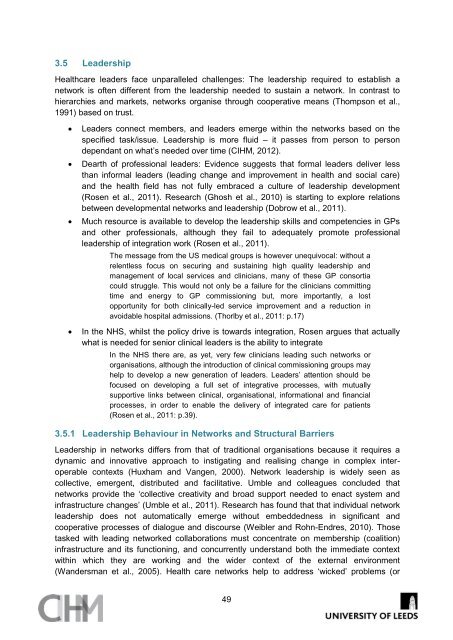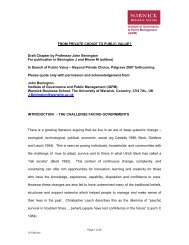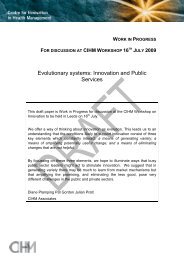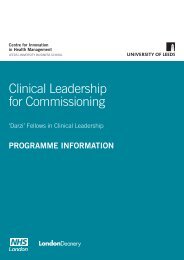3.5 Leadership<strong>Health</strong>care leaders face unparalleled challenges: The leadership required to establish anetwork is often different from <strong>the</strong> leadership needed to sustain a network. In contrast tohierarchies and markets, networks organise through cooperative means (Thompson et al.,1991) based on trust.Leaders connect members, and leaders emerge within <strong>the</strong> networks based on <strong>the</strong>specified task/issue. Leadership is more fluid – it passes from person to persondependant on what’s needed over time (CIHM, 2012).Dearth of professional leaders: Evidence suggests that <strong>for</strong>mal leaders deliver lessthan in<strong>for</strong>mal leaders (leading change and improvement in health and social care)and <strong>the</strong> health field has not fully embraced a culture of leadership development(Rosen et al., 2011). Research (Ghosh et al., 2010) is starting to explore relationsbetween developmental networks and leadership (Dobrow et al., 2011).Much resource is available to develop <strong>the</strong> leadership skills and competencies in GPsand o<strong>the</strong>r professionals, although <strong>the</strong>y fail to adequately promote professionalleadership of integration work (Rosen et al., 2011).The message from <strong>the</strong> US medical groups is however unequivocal: without arelentless focus on securing and sustaining high quality leadership andmanagement of local services and clinicians, many of <strong>the</strong>se GP consortiacould struggle. This would not only be a failure <strong>for</strong> <strong>the</strong> clinicians committingtime and energy to GP commissioning but, more importantly, a lostopportunity <strong>for</strong> both clinically-led service improvement and a reduction inavoidable hospital admissions. (Thorlby et al., 2011: p.17)In <strong>the</strong> NHS, whilst <strong>the</strong> policy drive is towards integration, Rosen argues that actuallywhat is needed <strong>for</strong> senior clinical leaders is <strong>the</strong> ability to integrateIn <strong>the</strong> NHS <strong>the</strong>re are, as yet, very few clinicians leading such networks ororganisations, although <strong>the</strong> introduction of clinical commissioning groups mayhelp to develop a new generation of leaders. Leaders’ attention should befocused on developing a full set of integrative processes, with mutuallysupportive links between clinical, organisational, in<strong>for</strong>mational and financialprocesses, in order to enable <strong>the</strong> delivery of integrated care <strong>for</strong> patients(Rosen et al., 2011: p.39).3.5.1 Leadership Behaviour in <strong>Networks</strong> and Structural BarriersLeadership in networks differs from that of traditional organisations because it requires adynamic and innovative approach to instigating and realising change in complex interoperablecontexts (Huxham and Vangen, 2000). Network leadership is widely seen ascollective, emergent, distributed and facilitative. Umble and colleagues concluded thatnetworks provide <strong>the</strong> ‘collective creativity and broad support needed to enact system andinfrastructure changes’ (Umble et al., 2011). Research has found that that individual networkleadership does not automatically emerge without embeddedness in significant andcooperative processes of dialogue and discourse (Weibler and Rohn-Endres, 2010). Thosetasked with leading networked collaborations must concentrate on membership (coalition)infrastructure and its functioning, and concurrently understand both <strong>the</strong> immediate contextwithin which <strong>the</strong>y are working and <strong>the</strong> wider context of <strong>the</strong> external environment(Wandersman et al., 2005). <strong>Health</strong> care networks help to address ‘wicked’ problems (or49
perhaps are used as a way to avoid solving <strong>the</strong> tough/challenging issues) which encompassa variety of agencies and professions and provide alternative <strong>for</strong>ms of care configuration andservice delivery. Studies have shown that such networks can achieve significant levels ofclinical support, authority and legitimacy when supported by an evidence based approach(Ferlie et al., 2010). However, <strong>Networks</strong> have also been known to augment complexity,eventually consisting of small groupings of policy elites (little dictators) to <strong>the</strong> exclusion ofo<strong>the</strong>rs, and may lose vigour and purpose with <strong>the</strong> leadership element becoming populated(Ferlie et al., 2010). SNA data was used by Webster and colleagues (Webster et al., 1999) toanalyse differences across eight US mental-health (case management) teams in a municipalmental health system. Male supervisors were seen as key figures <strong>for</strong> advice-based andsocial relations than <strong>the</strong>ir females counterparts, with <strong>the</strong> <strong>for</strong>mer displaying autocraticleadership styles in comparison to <strong>the</strong> more democratic style of women supervisors(Cunningham et al., 2011). Heroic and hierarchical <strong>for</strong>ms of leadership that focus on aleader’s competencies and behaviours are increasingly unsuitable in <strong>the</strong> current networkedenvironment (Collinson and Collinson, 2009). Leadership is largely context dependant andoccurs in situ: hence it’s intractable nature ensures that it cannot be condensed into variousconstituent elements (Bolden and Gosling, 2006).Leadership behaviour in hierarchies are set to <strong>the</strong> direction, <strong>the</strong> expected behaviours, <strong>the</strong> rules <strong>for</strong> doing business,behaviours expected, and exercising positional power (power over) (CIHM, 2012).Leadership behaviour in networks is perhaps <strong>the</strong> difference between <strong>the</strong> different types ofpower and how <strong>the</strong>y relate to structural types (Cook, 1977). One should consider <strong>the</strong>leadership capacities of participant organisations where capacity can be found in <strong>the</strong>individuals and also <strong>the</strong> structures that are created to enable collaborative relations.Subsequently, top down and hierarchical models of leadership are inappropriate <strong>for</strong> dynamicnetwork arrangements. Research has explored successful leadership models <strong>for</strong> effectivemental-health treatment (Cleary et al., 2011). They found that trans<strong>for</strong>mational anddistributed leadership models were harmonious with <strong>the</strong> values embedded in mental healthcare 13 . Cleary et al, drew upon literature which highlights <strong>the</strong> overarching and covert natureof organisational power within healthcare settings, but queried whe<strong>the</strong>r trans<strong>for</strong>mationalleadership (practiced within certain clinical contexts), can impact upon patient care beyondthose boundaries. Cleary and colleagues conclude by acknowledging <strong>the</strong> fact that patientsand nurses will continue to engage within <strong>the</strong>se socio-spatial configurations, hence <strong>the</strong> need<strong>for</strong> deeper knowledge about effective leadership. Martin and colleagues concluded from<strong>the</strong>ir research on leadership within public service networks that structure provides <strong>the</strong>freedom <strong>for</strong> individual actors (leaders) to per<strong>for</strong>m <strong>the</strong>ir roles and functions and that <strong>the</strong>relationship between structure and agency is inextricably aligned (2009). Effective leadershave <strong>the</strong> potential to enact change through structures and processes (of a network), yet <strong>the</strong>network itself contains o<strong>the</strong>r network <strong>for</strong>ms which inhibit one’s ability to achieve certainobjectives (i.e. change) without harmonizing action beyond <strong>the</strong> confines of <strong>the</strong> network(Martin et al., 2009). This reflects <strong>the</strong> perspective of Williams and Sullivan who acknowledgethat actors may still construct outcomes, yet <strong>the</strong> parameters of <strong>the</strong>ir faculty to act (e.g13In contrast to Cleary and colleagues’ literature review findings where both models weremore idealised than experienced.50
- Page 1 and 2: Centre for Innovation in Health Man
- Page 3 and 4: 2.4 Agency Networks, Policy Network
- Page 5 and 6: ‘Networks can take many forms to
- Page 7 and 8: of the parts.based uponintegrity.Ho
- Page 9 and 10: Why theyfailIf it struggles toachie
- Page 11 and 12: Table 2: Examples of NetworksManage
- Page 13 and 14: 1.1.3 The scoping methodologyA brai
- Page 15 and 16: pathways, managed clinical networks
- Page 17 and 18: in terms of a shared vision, common
- Page 19 and 20: Rangachari (Rangachari, 2008) took
- Page 21 and 22: Turrini et al (2009) also raise fou
- Page 23 and 24: Trying things out: just taking some
- Page 25 and 26: Success is attributed/dependant on
- Page 27 and 28: 2.2 Developmental NetworksCharacter
- Page 29 and 30: transaction costs. Also: ‘...the
- Page 31 and 32: The authors acknowledge that the mo
- Page 33 and 34: Research has explored regional clus
- Page 35 and 36: Networks are essentially a form of
- Page 37 and 38: significant social bonds and joint
- Page 39 and 40: 3 Network Evaluation and Future of
- Page 41 and 42: contractual relationships; the arra
- Page 43 and 44: to meet the legal and policy based
- Page 45 and 46: Sectors Networks (PSNs) are underst
- Page 47 and 48: coordinated manner, unconstrained b
- Page 49: Research has shown that there is no
- Page 53 and 54: attempted to determine (section 1.2
- Page 55 and 56: Leadership, 2, 147-163.BOURDIEU, P.
- Page 57 and 58: DOUGHERTY, T. W., CHEUNG, Y. H. & F
- Page 59 and 60: other social media are reshaping he
- Page 61 and 62: NHS SCOTLAND. 2010. Review of nine
- Page 63 and 64: mental patients in a Manhattan SRO
- Page 65 and 66: AppendixPrinciples of engagement (M
- Page 67 and 68: NHS Networks: The document (NHS NET
- Page 69 and 70: iPrinciples of engagement (MENDIZAB
- Page 71 and 72: • frequently updated - not live,
















